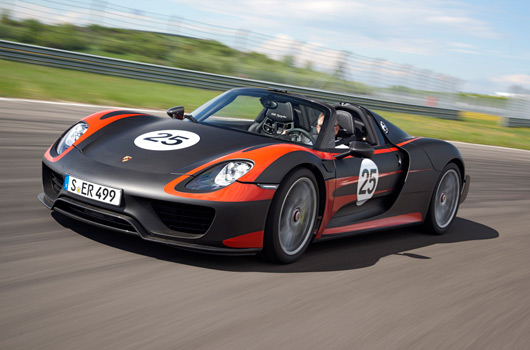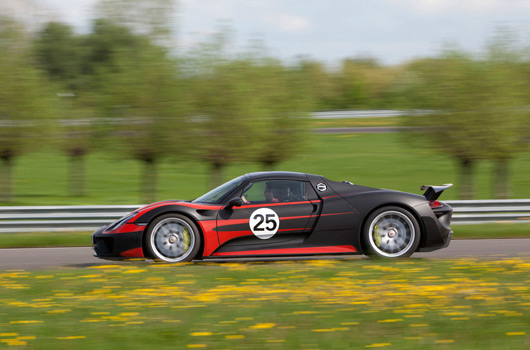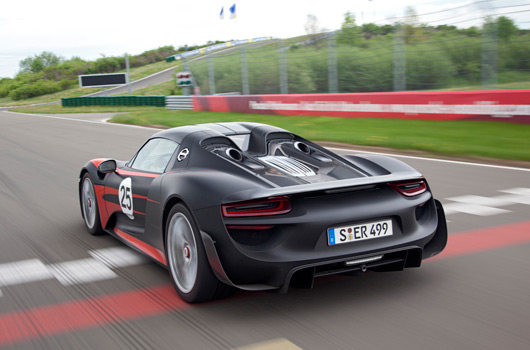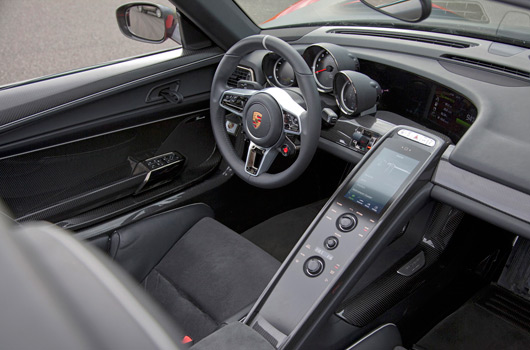It seems the Porsche 918 Spyder has had more announcements and reveals than a Hollywood wannabe, but it’s about to have its final and complete unveiling at Frankfurt next week.
We’ll bring you more then, but first here’s what Porsche has to say:
The 918 Spyder is the continuation of the traditional Porsche DNA in a ground-breaking sportscar concept. Designed from the start to be a high-performance hybrid, the 918 Spyder boasts an unprecedented combination of performance (offering the 887-bhp output of a super sportscar) and the virtually silent locomotion of an electric vehicle. The vehicle is able to accelerate from 0 to 100 km/h in 2.8 seconds and offers an average standard fuel consumption of between 3.0 and 3.3 litres/100 km. The 918 Spyder concept also allows a combustion engine to be combined with an electric motor-based drive to further optimise the dynamic performance of the vehicle.
Joining the 918 Spyder in Frankfurt will be the new Panamera, the 50 years 911, and the 911 Turbo.
Spectacular technology pioneer goes into series production
The Porsche 918 Spyder celebrates its world debut at the IAA 2013
Stuttgart. The technologically pioneering Porsche 918 Spyder (1) is celebrating its debut at this year’s International Motor Show (IAA) in Frankfurt. The super sportscar with plug-in hybrid drive marks the beginning of a new era for sportscar manufacturing. Never before has a super sportscar designed for everyday use offered such an impressive dynamic performance combined with the fuel consumption of a compact car. In setting this technological benchmark, the Porsche 918 Spyder is taking on a pioneering role similar to that of the 911 when it was unveiled at the IAA fifty years ago. To mark this anniversary, Porsche is presenting the “50 years 911” limited edition model. Based on the 911 Carrera S platform, this special model combines traditional 911 features with state-of-the-art technology. Porsche is completing its sportscar line-up with the new 911 Turbo, which is being presented to the public for the first time at the major trade show in Frankfurt.
In addition, the new Panamera generation (2) is demonstrating the unique coverage of the Porsche range of models. As the first plug-in hybrid in the luxury class, the pioneering Panamera S E-Hybrid (3) is proving that Porsche is leading the field with its expertise in the development of fuel-efficient drive concepts for sportscars. Also on show is the more fuel-efficient Gran Turismo for long distance driving, the Panamera Diesel, which now offers an output of 300 bhp.
The outstanding combination of performance and efficiency typical of the brand is still Porsche’s secret weapon when it comes to setting new sales records. Matthias Müller, President and CEO of Dr. Ing. h.c. F. Porsche AG recently said: “From January to July, we were able deliver around 95,300 new vehicles worldwide – that’s 17% more than in the first seven months of 2012. We are therefore very confident about the next few months and we now firmly believe we will have sold more vehicles by the end of 2013 than we did in the previous year. Based on how things are going at the moment, we are set to have another record year – and that’s in spite of the fact that the present economic climate is far from satisfactory.” 2012 was the most successful year to date in Porsche’s history, with 143,096 vehicles sold and sales of EUR 13.9 billion.
Porsche’s genetic blueprint for the future: The 918 Spyder with high-performance hybrid
The 918 Spyder is the continuation of the traditional Porsche DNA in a ground-breaking sportscar concept. Designed from the start to be a high-performance hybrid, the 918 Spyder boasts an unprecedented combination of performance (offering the 887-bhp output of a super sportscar) and the virtually silent locomotion of an electric vehicle. The vehicle is able to accelerate from 0 to 100 km/h in 2.8 seconds and offers an average standard fuel consumption of between 3.0 and 3.3 litres/100 km. The 918 Spyder concept also allows a combustion engine to be combined with an electric motor-based drive to further optimise the dynamic performance of the vehicle.
A sportscar icon celebrates its anniversary with the “50 years 911” limited edition model (4)
Since its debut at the IAA in September 1963, the 911 has been revered by car enthusiasts around the world as the epitome of the sportscar. The bestseller is now celebrating its 50th anniversary in Frankfurt, and Porsche is marking the occasion with a limited edition model based on the current 911 Carrera S. Only 1963 special models are available – the same number as the year of the 911 world premiere. In addition to a comprehensive features package and various visual references to the early years of this iconic sportscar, this very special 911 model exclusively combines the wide body of the all-wheel models with the traditional rear-wheel drive of the original 911, which also featured a flat-six engine that transmitted power to the rear wheels.
The new 911 Turbo: maximum driving dynamics, minimum fuel consumption (5)
The first 911 Turbo prototype was showcased at the IAA in 1973, ten years after the original 911 made its debut. For the 40th anniversary of the model, Porsche is presenting the new generation 911 Turbo and Turbo S, which offer the pinnacle of technology and dynamic performance in the 911 model line. Features like the new all-wheel drive, active rear-axle steering, adaptive aerodynamics, full-LED headlights and the 560-bhp, flat-six engine with double turbocharging underscore the role of the new 911 Turbo generation as a technological benchmark both for race cars and super sportscars intended for everyday use. The dynamic performance has also been improved via the active Porsche Dynamic Chassis Control (PDCC) rolling-motion compensation system, which is making its first appearance in the 911 Turbo models. This system is part of the standard equipment for the 911 Turbo S, as is the Sport Chrono package with dynamic engine mountings and PCCB ceramic brakes, all of which are also available as an option for the 911 Turbo. These modifications reduced the lap time of the new 911 Turbo S at the North Loop of the Nürburgring to 7:27 minutes – on standard production tyres, of course. At the same time, both top sportscars are now even more efficient with a New European Driving Cycle (NEDC) fuel consumption of 9.7 litres/100 km, which is 15% lower than before.
Visitors, potential customers and existing customers can find the Porsche stand (number A12) in hall 3.0 at the IAA. A press conference will be held at the Porsche stand on September 10, at 10.00 a.m. You can follow the Porsche press conference under the link: http://www.media-server.com/m/p/aj2v4htx/lan/en
1) 918 Spyder: Fuel consumption (combined) 3.3 – 3.0 l/100 km; electrical consumption (combined) 13.0 – 12.5 Wh/100 km; CO2 emissions 79 – 70 g/km
2) Panamera: Fuel consumption (combined) 10.7 – 6.4 l/100 km; CO2 emissions 249 – 169 g/km
3) Panamera S E-Hybrid: Fuel consumption (combined) 3.1 l/100 km; electrical consumption (combined) 16.2 Wh/100 km; CO2 emissions 71 g/km
4) 911 50th Anniversary Edition: Fuel consumption urban 13.8 – 12.2 l/100 km; non-urban 7.1 – 6.7 l/100 km; combined 9.5 – 8.7 l/100 km; CO2 emissions 224 – 205 g/km
5) 911 Turbo and 911 Turbo S: Fuel consumption urban 13.2 l/100 km; non-urban 7.7 l/100 km; combined 9.7 l/100 km; CO2 emissions 227 g/km



